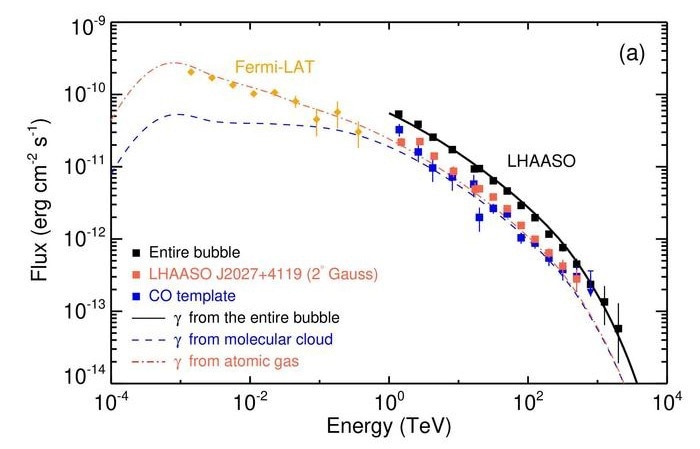Feb 22 2024Reviewed by Lexie Corner
For the first time, the origin of cosmic rays with an energy higher than 10 Peta-Electronvolt (PeV, 1 PeV=1015 eV) has been found in the Cygnus star-forming region, thanks to the discovery of a giant ultra-high-energy gamma-ray bubble structure by the Large High Altitude Air Shower Observatory (LHAASO).
 The Spectral Energy Distribution of the Cygnus Bubble and the Model Fitting Results. Image Credit: Prof. Cao et al.
The Spectral Energy Distribution of the Cygnus Bubble and the Model Fitting Results. Image Credit: Prof. Cao et al.
Science Bulletin published this accomplishment as a cover story.
The Chinese Academy of Sciences’ Institute of High Energy Physics spokesperson, Prof. Zhen Cao, led the LHAASO Collaboration in completing the research. The paper's co-corresponding authors are Prof. Ruizhi Yang, Prof. Ruoyu Liu, Dr. Chuandong Gao, and Dr. Cong Li.
Cosmic rays are charged space particles primarily made up of protons. One of the most significant open questions in contemporary astrophysics is the origin of cosmic rays. The “knee” of the cosmic ray energy spectrum gets its name from its shape, which resembles a knee joint.
Over the past few decades, cosmic ray measurements have shown a break in the energy spectrum around 1 PeV (that is, the distribution of cosmic ray abundance as a function of the particle energy).
The existence of the “knee” also suggests that the energy limit for accelerating protons from the majority of the Milky Way's cosmic ray sources is approximately a few PeV. Scientists believe cosmic rays with energies below the “knee” originate from astrophysical objects within the Milky Way. Still, one of the most fascinating subjects in recent years of cosmic ray research is the origin of cosmic rays in the “knee” region, which remains an unanswered mystery.
LHAASO has found a giant ultra-high-energy gamma-ray bubble structure in the Cygnus star-forming region. Multiple photons have been detected inside the structure with energies exceeding 1 PeV, with the highest being 2.5 PeV. This suggests that the structure contains a super cosmic ray accelerator that continuously accelerates high-energy cosmic ray particles up to 20 PeV and injects them into interstellar space.
Gamma rays are created when these high-energy cosmic rays collide with interstellar gas. The most promising candidate for the super cosmic ray accelerator is the massive star cluster (the OB association, Cygnus OB2) near the bubble's center. The intensity of these gamma-ray photons is correlated with the distribution of the surrounding gas.
These stars have radiation luminosities hundreds to millions of times greater than the Sun's, and their immense radiation pressure causes the stars' surface material to be blasted away, creating dynamic stellar winds that can reach thousands of kilometers per second. The violent collisions between stellar winds and the collisions of stellar winds with the surrounding interstellar medium have created perfect locations for effective particle acceleration.
As of now, this is the first known super cosmic ray accelerator. LHAASO is anticipated to find more supercosmic ray accelerators as observation time increases, potentially providing an answer to the question of where cosmic rays originate in the Milky Way.
According to LHAASO's observation, the cosmic ray density in the surrounding interstellar space is significantly increased by the super cosmic ray accelerator inside the bubble, far exceeding the average level of cosmic rays in the Milky Way. A potential explanation for the excess of diffuse gamma-ray emission from the Galactic Plane previously detected by LHAASO is offered by the density excess, whose spatial extension even surpasses the observed range of bubbles.
Prof. Elena Amato, a renowned astrophysicist from the Italian National Institute for Astrophysics (INAF), highlighted the impact of the discovery on the origin of cosmic rays.
Not only impacts our understanding of diffuse emission, but has also very relevant consequences on our description of cosmic ray (CR) transport in the Galaxy.
Elena Amato, Professor and Astrophysicist, Italian National Institute for Astrophysical
Located at 4410 m on Mount Haizi in Daocheng County, Sichuan Province, China, LHAASO is a major scientific and technological facility dedicated to cosmic ray research. It is a composite array consisting of 18 wide-angle Cherenkov telescopes, a 78,000-square-meter water Cherenkov detector array, and a 1 square-kilometer ground array of 5216 electromagnetic particle detectors and 1188 muon detectors. After LHAASO was finished in July 2021, reliable and high-quality operation started. It is the world's most sensitive ultra-high-energy gamma-ray detector.
To achieve open sharing of facility platforms and observational data, the Institute of High Energy Physics, which operates the facility, employs a universal international cooperation model. LHAASO has about 280 members and 32 domestic and international astrophysics research institutions as international collaboration members.
Journal Reference:
Amato, E., et al. (2024) An ultrahigh-energy ℽ -ray bubble powered by a super PeVatron. Science Bulletin. doi.org/10.1016/j.scib.2023.12.040.
Source: https://english.cas.cn/